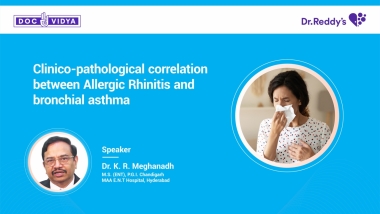test
test
test
test
test
test
test
test
test
test
Videos
Clinico-pathological correlation between Allergic Rhinitis and bronchial asthma
Interrelationship of Allergic Rhinitis and bronchial asthma
Clinico-pathological correlation between Allergic Rhinitis and bronchial asthma
Interrelationship of Allergic Rhinitis and bronchial asthma
Clinico-pathological correlation between Allergic Rhinitis and bronchial asthma
Interrelationship of Allergic Rhinitis and bronchial asthma
Differential diagnosis for Allergic Rhinitis
Understanding the differential diagnosis for Allergic Rhinitis
Differential diagnosis for Allergic Rhinitis
Understanding the differential diagnosis for Allergic Rhinitis
Differential diagnosis for Allergic Rhinitis
Understanding the differential diagnosis for Allergic Rhinitis
Courses
Medshorts

Regular exercise reduces daily inhaled corticosteroids dosage without compromising asthma control
According to a new study, regular physical exercise for 6 months can reduce the daily inhaled corticosteroids (ICS) dose without compromising asthma control. The results of this study were published in the Journal of allergy and clinical immunology.
150 ICS-treated symptomatic asthma patients were randomly assigned to either an exercise intervention group, who exercised three times a week for 6 months or a control group who continued their usual lifestyle. The primary outcome was the proportion who had a 25% or greater reduction in ICS dose at 6 months. Secondary outcome of this study was actual ICS dose (in micrograms) per day.
63% in the exercise group achieved the primary outcome compared to 50% in the control group at the 6-month visit. Additionally, the daily ICS dose decreased in favor of the exercise group with a mean difference of -234 μg, a 24% reduction from baseline.
Based on the above findings, this study showed that regular physical exercise for 6 months is safe, well tolerated and can reduce the daily ICS dose without compromising asthma control.

Regular exercise reduces daily inhaled corticosteroids dosage without compromising asthma control
According to a new study, regular physical exercise for 6 months can reduce the daily inhaled corticosteroids (ICS) dose without compromising asthma control. The results of this study were published in the Journal of allergy and clinical immunology.
150 ICS-treated symptomatic asthma patients were randomly assigned to either an exercise intervention group, who exercised three times a week for 6 months or a control group who continued their usual lifestyle. The primary outcome was the proportion who had a 25% or greater reduction in ICS dose at 6 months. Secondary outcome of this study was actual ICS dose (in micrograms) per day.
63% in the exercise group achieved the primary outcome compared to 50% in the control group at the 6-month visit. Additionally, the daily ICS dose decreased in favor of the exercise group with a mean difference of -234 μg, a 24% reduction from baseline.
Based on the above findings, this study showed that regular physical exercise for 6 months is safe, well tolerated and can reduce the daily ICS dose without compromising asthma control.


Regular exercise reduces daily inhaled corticosteroids dosage without compromising asthma control
According to a new study, regular physical exercise for 6 months can reduce the daily inhaled corticosteroids (ICS) dose without compromising asthma control. The results of this study were published in the Journal of allergy and clinical immunology.
150 ICS-treated symptomatic asthma patients were randomly assigned to either an exercise intervention group, who exercised three times a week for 6 months or a control group who continued their usual lifestyle. The primary outcome was the proportion who had a 25% or greater reduction in ICS dose at 6 months. Secondary outcome of this study was actual ICS dose (in micrograms) per day.
63% in the exercise group achieved the primary outcome compared to 50% in the control group at the 6-month visit. Additionally, the daily ICS dose decreased in favor of the exercise group with a mean difference of -234 μg, a 24% reduction from baseline.
Based on the above findings, this study showed that regular physical exercise for 6 months is safe, well tolerated and can reduce the daily ICS dose without compromising asthma control.

Piperacillin tazobactam with high-frequency chest-wall oscillation is effective to treat acute exacerbations of COPD
According to a new study, piperacillin tazobactam combined with high-frequency chest-wall oscillation (HFCWO) for sputum evacuation is safe and can effectively treat patients with pneumonia in acute exacerbation of chronic obstructive pulmonary disease (AE-COPD). This study was published in the journal, Alternative Therapies in Health and Medicine.
This prospective, randomized controlled trial included 92 patients who had been admitted to the hospital with AE-COPD combined with pneumonia. The participants were randomized into two groups, each with 46 participants. The control group where the participants received conventional treatment with oxygen, antibiotics, antispasmodics, antiasthmatic drugs, and phlegmolytic drugs as well as HFCWO; and the intervention group received piperacillin tazobactam along with these treatments.
The results revealed that Piperacillin tazobactam combined with HFCWO for sputum evacuation can effectively shorten the disappearance time of clinical symptoms and hospitalization time of patients who have AE-COPD combined with pneumonia; improve patients’ pulmonary function; increase the IL-2 and IL-10 and decrease the TNF-α, CRP, and PCT levels; and regulate the blood-gas-analysis index, with few adverse effects and high safety .
Therefore, piperacillin tazobactam combined with HFCWO for sputum evacuation is effective to treat pneumonia in AE-COPD.

Piperacillin tazobactam with high-frequency chest-wall oscillation is effective to treat acute exacerbations of COPD
According to a new study, piperacillin tazobactam combined with high-frequency chest-wall oscillation (HFCWO) for sputum evacuation is safe and can effectively treat patients with pneumonia in acute exacerbation of chronic obstructive pulmonary disease (AE-COPD). This study was published in the journal, Alternative Therapies in Health and Medicine.
This prospective, randomized controlled trial included 92 patients who had been admitted to the hospital with AE-COPD combined with pneumonia. The participants were randomized into two groups, each with 46 participants. The control group where the participants received conventional treatment with oxygen, antibiotics, antispasmodics, antiasthmatic drugs, and phlegmolytic drugs as well as HFCWO; and the intervention group received piperacillin tazobactam along with these treatments.
The results revealed that Piperacillin tazobactam combined with HFCWO for sputum evacuation can effectively shorten the disappearance time of clinical symptoms and hospitalization time of patients who have AE-COPD combined with pneumonia; improve patients’ pulmonary function; increase the IL-2 and IL-10 and decrease the TNF-α, CRP, and PCT levels; and regulate the blood-gas-analysis index, with few adverse effects and high safety .
Therefore, piperacillin tazobactam combined with HFCWO for sputum evacuation is effective to treat pneumonia in AE-COPD.


Piperacillin tazobactam with high-frequency chest-wall oscillation is effective to treat acute exacerbations of COPD
According to a new study, piperacillin tazobactam combined with high-frequency chest-wall oscillation (HFCWO) for sputum evacuation is safe and can effectively treat patients with pneumonia in acute exacerbation of chronic obstructive pulmonary disease (AE-COPD). This study was published in the journal, Alternative Therapies in Health and Medicine.
This prospective, randomized controlled trial included 92 patients who had been admitted to the hospital with AE-COPD combined with pneumonia. The participants were randomized into two groups, each with 46 participants. The control group where the participants received conventional treatment with oxygen, antibiotics, antispasmodics, antiasthmatic drugs, and phlegmolytic drugs as well as HFCWO; and the intervention group received piperacillin tazobactam along with these treatments.
The results revealed that Piperacillin tazobactam combined with HFCWO for sputum evacuation can effectively shorten the disappearance time of clinical symptoms and hospitalization time of patients who have AE-COPD combined with pneumonia; improve patients’ pulmonary function; increase the IL-2 and IL-10 and decrease the TNF-α, CRP, and PCT levels; and regulate the blood-gas-analysis index, with few adverse effects and high safety .
Therefore, piperacillin tazobactam combined with HFCWO for sputum evacuation is effective to treat pneumonia in AE-COPD.

Telemark study shows association of chronic rhinosinusitis with chronic bronchitis
The findings of a recent study on adults suffering from chronic bronchitis (CB) showed that their condition was associated with chronic rhinosinusitis (CRS) as well.
The results of the study were published in the journal, BMC Pulmonary Medicine. This prospective study included 7393 adult subjects from Norway over a period of 5 years. They were asked to answer a comprehensive respiratory questionnaire in 2013 and repeat again in 2018. Subjects who developed CB in 2013 were excluded from the analyses. Only new cases who developed CB in 2018 were considered for analyses irrespective of having CRS in 2013 or not.

Telemark study shows association of chronic rhinosinusitis with chronic bronchitis
The findings of a recent study on adults suffering from chronic bronchitis (CB) showed that their condition was associated with chronic rhinosinusitis (CRS) as well.
The results of the study were published in the journal, BMC Pulmonary Medicine. This prospective study included 7393 adult subjects from Norway over a period of 5 years. They were asked to answer a comprehensive respiratory questionnaire in 2013 and repeat again in 2018. Subjects who developed CB in 2013 were excluded from the analyses. Only new cases who developed CB in 2018 were considered for analyses irrespective of having CRS in 2013 or not.


Telemark study shows association of chronic rhinosinusitis with chronic bronchitis
The findings of a recent study on adults suffering from chronic bronchitis (CB) showed that their condition was associated with chronic rhinosinusitis (CRS) as well.
The results of the study were published in the journal, BMC Pulmonary Medicine. This prospective study included 7393 adult subjects from Norway over a period of 5 years. They were asked to answer a comprehensive respiratory questionnaire in 2013 and repeat again in 2018. Subjects who developed CB in 2013 were excluded from the analyses. Only new cases who developed CB in 2018 were considered for analyses irrespective of having CRS in 2013 or not.











